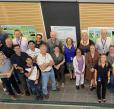Our Science
A list of all ANSTO's research programs and themes.

Showing 1 - 20 of 2623 results
A list of all ANSTO's research programs and themes.
ANSTO is committed to providing products that meet or exceed the requirements and expectations of our customers and stakeholders in compliance with all relevant national and international standards, statutory and regulatory requirements.
Our people, the custodians of Australia’s nuclear and accelerator expertise, are amongst our nation’s most talented researchers, scientists, engineers and nuclear experts. Everyday we work to respond to the growing nuclear science and technology needs of Australia and the world.

In April 15, 1953, Australia entered the nuclear science arena, when the Atomic Energy Act came into effect. The Australian Atomic Energy Commission (AAEC) followed and in 1987 the AAEC evolved into the Australian Nuclear Science and Technology Organisation (ANSTO) as it’s known today.

Recent news, highlights, and impact case studies from CAS’ research and industry user communities and collaborations/partners
ANSTO provides the Australian and international community with services that improve human health, support industry and protect the environment.

ANSTO makes its nuclear science and engineering facilities available to the research community and industry through peer-reviewed, collaborative and commercial arrangements. We have provided links to some of ANSTO's most sought-after facilities and instruments.

ANSTO's Sydney locations are home to the Open Pool Australian Light-water (OPAL) multi-purpose reactor, the Centre for Accelerator Science (CAS), the Australian Centre for Neutron Scattering, the National Research Cyclotron and the National Deuteration Facility.
Physicist and cancer research Dr Mitra Safavi-Naeini, Macromolecular crystallography beamline scientist Dr Eleanor Campbell and Engineering Support Workshop Manager Bianca Shepherd have been chosen by Science and Technology Australia as the next Superstars of STEM
The process by which plastic degrades in the ocean facilitates its entry into the natural carbon cycle efficiently as carbon dioxide.
ANSTO scientists share approach on the global stage at the IAEA General Conference.
Scientists at ANSTO characterise structures with atomic detail using probes such as x-rays, electrons, neutrons and ions.